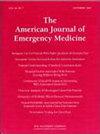Quick sequential organ failure assessment and Fournier gangrene severity index as predictors for mortality in Fournier gangrene patients: A retrospective cohort study of 153 patients
IF 2.7
3区 医学
Q1 EMERGENCY MEDICINE
引用次数: 0
Abstract
Introduction
Fournier's gangrene (FG) is a rare, rapidly progressing necrotizing fasciitis of the external genitalia and perineum, with mortality rates ranging from 20 % to 50 %. Early identification of high-risk patients is essential for timely intervention. The quick Sequential Organ Failure Assessment (qSOFA) and the Fournier Gangrene Severity Index (FGSI) are commonly used prognostic tools, but their comparative performance in FG remains unclear. This study evaluates their predictive accuracy in a large FG cohort and explores their complementary roles in clinical decision-making.
Methods
A retrospective cohort study was conducted on 153 FG patients admitted to Hasan Sadikin General Hospital, Indonesia, from January 2013 to December 2023. Clinical and laboratory data, including qSOFA and FGSI scores, were analyzed to assess in-hospital mortality. The predictive performance of both scoring systems was evaluated using receiver operating characteristic (ROC) curve analysis, with sensitivity, specificity, positive predictive value (PPV), and negative predictive value (NPV). Multivariate logistic regression estimated adjusted odds ratios (ORs) for mortality while accounting for age and comorbidities.
Results
The overall mortality rate was 30 %. Non-survivors were significantly older and had higher rates of comorbidities, including acute kidney injury and cardiovascular disease. Both qSOFA and FGSI demonstrated strong predictive capabilities (AUC = 0.818). qSOFA had a specificity of 94.6 % but lower sensitivity (62.2 %), making it effective for identifying low-risk patients. FGSI demonstrated higher sensitivity (70.3 %) and specificity (85.9 %), making it more suitable for high-risk patient identification. Combining qSOFA's rapid bedside utility with FGSI's comprehensive risk assessment offers a powerful strategy for timely intervention and resource allocation.
Conclusions
This study is among the first to compare qSOFA and FGSI in a large FG cohort, highlighting their complementary roles in clinical decision-making. A combined approach can enhance early risk stratification, optimize critical care resource allocation, and improve patient outcomes. Future research should explore integrating biomarkers such as lactate and procalcitonin to refine predictive accuracy, particularly in resource-limited settings.
快速序贯器官衰竭评估和富尼耶坏疽严重程度指数作为富尼耶坏疽患者死亡率的预测指标:153例患者的回顾性队列研究。
简介:富尼耶坏疽(FG)是一种罕见的、进展迅速的外生殖器和会阴坏死性筋膜炎,死亡率为20%至50%。早期识别高危患者对于及时干预至关重要。快速顺序器官衰竭评估(qSOFA)和Fournier坏疽严重程度指数(FGSI)是常用的预后工具,但它们在FG中的比较性能尚不清楚。本研究在一个大型FG队列中评估了它们的预测准确性,并探讨了它们在临床决策中的补充作用。方法:对2013年1月至2023年12月印度尼西亚Hasan Sadikin总医院收治的153例FG患者进行回顾性队列研究。分析临床和实验室数据,包括qSOFA和FGSI评分,以评估住院死亡率。采用受试者工作特征(ROC)曲线分析评估两种评分系统的预测性能,包括敏感性、特异性、阳性预测值(PPV)和阴性预测值(NPV)。考虑到年龄和合并症,多因素logistic回归估计死亡率的校正优势比(ORs)。结果:总死亡率为30%。非幸存者明显年龄更大,合并症发生率更高,包括急性肾损伤和心血管疾病。qSOFA和FGSI均表现出较强的预测能力(AUC = 0.818)。qSOFA特异性为94.6%,但敏感性较低(62.2%),可有效识别低危患者。FGSI表现出更高的敏感性(70.3%)和特异性(85.9%),使其更适合高危患者的识别。将qSOFA的快速床边效用与FGSI的全面风险评估相结合,为及时干预和资源分配提供了强有力的策略。结论:本研究是第一个在大型FG队列中比较qSOFA和FGSI的研究,强调了它们在临床决策中的互补作用。综合方法可以加强早期风险分层,优化重症监护资源分配,改善患者预后。未来的研究应该探索整合生物标志物,如乳酸和降钙素原,以提高预测的准确性,特别是在资源有限的情况下。
本文章由计算机程序翻译,如有差异,请以英文原文为准。
求助全文
约1分钟内获得全文
求助全文
来源期刊
CiteScore
6.00
自引率
5.60%
发文量
730
审稿时长
42 days
期刊介绍:
A distinctive blend of practicality and scholarliness makes the American Journal of Emergency Medicine a key source for information on emergency medical care. Covering all activities concerned with emergency medicine, it is the journal to turn to for information to help increase the ability to understand, recognize and treat emergency conditions. Issues contain clinical articles, case reports, review articles, editorials, international notes, book reviews and more.

 求助内容:
求助内容: 应助结果提醒方式:
应助结果提醒方式:


